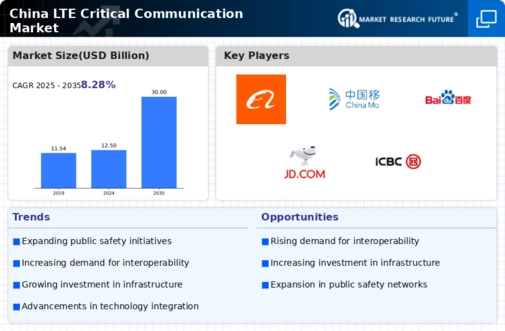Expansion of Smart City Initiatives
The expansion of smart city initiatives in China is significantly influencing the lte critical-communication market. As cities evolve into smart ecosystems, the demand for advanced communication systems that support real-time data exchange and connectivity is increasing. These initiatives often incorporate IoT devices, which require robust communication networks to function effectively. The Chinese government has committed substantial resources to develop smart city projects, with investments projected to reach $300 billion by 2025. This focus on smart city infrastructure is likely to drive the adoption of lte critical-communication solutions, potentially increasing market growth by 22% as cities seek to enhance public safety and operational efficiency.
Rising Demand for Secure Communication
In the context of the lte critical-communication market, the increasing need for secure communication channels is becoming increasingly evident in China. With the rise in cyber threats and data breaches, organizations are prioritizing secure communication solutions to protect sensitive information. This trend is particularly pronounced in sectors such as public safety, healthcare, and finance, where the integrity of communication is paramount. As a result, the market is witnessing a surge in demand for encryption technologies and secure communication protocols. Analysts estimate that the market for secure lte critical-communication solutions could grow by 20% annually, reflecting the urgent need for robust security measures in communication systems.
Government Initiatives for Public Safety
The lte critical-communication market in China is experiencing a notable boost due to various government initiatives aimed at enhancing public safety. The Chinese government has been actively investing in advanced communication technologies to ensure efficient emergency response systems. For instance, the Ministry of Emergency Management has allocated substantial funding to develop integrated communication networks that facilitate real-time data sharing among first responders. This investment is projected to increase the market's growth rate by approximately 15% over the next five years. Furthermore, the emphasis on disaster management and public safety has led to the establishment of regulatory frameworks that mandate the adoption of reliable communication systems, thereby driving demand for lte critical-communication solutions.
Increased Focus on Interagency Collaboration
The lte critical-communication market is witnessing a growing emphasis on interagency collaboration within China. Various governmental and non-governmental organizations are recognizing the importance of seamless communication during emergencies. This trend is leading to the establishment of joint training programs and communication protocols that facilitate better coordination among different agencies. The Chinese government has initiated several projects aimed at enhancing interoperability among various emergency services, which is expected to drive the demand for integrated lte critical-communication solutions. As agencies work together more effectively, the market could see a growth rate of around 18% over the next few years, reflecting the critical need for cohesive communication strategies.
Technological Advancements in Communication Infrastructure
Technological advancements are playing a pivotal role in shaping the lte critical-communication market in China. The rapid evolution of communication technologies, including the deployment of 5G networks, is enhancing the capabilities of critical communication systems. These advancements enable faster data transmission, improved coverage, and lower latency, which are essential for effective emergency response. The Chinese government has been proactive in rolling out 5G infrastructure, with investments exceeding $100 billion in recent years. This infrastructure development is expected to bolster the lte critical-communication market, potentially increasing its value by 25% by 2030. As organizations adopt these new technologies, the efficiency and reliability of communication systems are likely to improve significantly.
















Leave a Comment